- Home
- Views On News
- Dec 28, 2021 - What India's Top 5 Biggest Wealth Destroyers Can Teach You About Investing...
What India's Top 5 Biggest Wealth Destroyers Can Teach You About Investing...

The BSE Sensex has gone up at a CAGR of 17% over the past five years, generating over 110% returns.
But during the same time, some stocks failed to take advantage of the bull run. In fact, many stocks fell more than 95% in the past five years.
If you had invested Rs 1 lakh in these stocks in 2016, you would now be left with a mere Rs 3,000-5,000.
Investing in fundamentally weak stocks and the ones that have corporate governance issues, doubtful related-party transactions, or heavy debt, can cause unparalleled damage.
In today's article, we look at top stocks that crashed big time over the past five years and turned out to be the biggest wealth destroyers. Among these beaten down stocks, most of them belong to the banking and finance segment.
#1 Reliance Capital
While you may think that this list would be topped by Reliance Power, that's not the case. The company which tops the chart of biggest wealth destroyers over the past five years is Reliance Capital.
Once a market darling, the troubles started for Reliance Capital after the sudden collapse of IL&FS in September 2018.
In 2019, the company's credit ratings were lowered almost every month from March 2019 to September 2019. In September, Care Ratings lowered the rating of Reliance Capital's debt facilities to 'Care D' implying that it's in default.
This apart, other troubles were brewing in the group. Reliance Communications was admitted to bankruptcy in May 2018. Reliance Infra was downgraded to 'D' in August 2018 by India Ratings, and Reliance Naval & Engineering was assigned a junk rating by Brickwork Ratings in September 2019.
Aiming for the sky, Anil Ambani backed Reliance group companies took on enormous amounts of debt. These entities started failing one after the other and the last one to fail was Reliance Capital.
Reliance Capital couldn't pay its creditors. It had little cash on its books. In June 2019, its auditor, PwC, resigned saying it wasn't satisfied by Reliance Capital's response to financial issues it had flagged.
Multiple debt defaults followed.
In December 2021, a Mumbai bench of the insolvency court admitted a plea to initiate a resolution process against Reliance Capital under the bankruptcy law.
With this, Reliance Capital became the fourth financial services firm to be admitted to the NCLT following DHFL and two SREI group firms.
Trading at a price of more than Rs 850 in 2017, Reliance Capital shares currently trade at a mere Rs 13.
That's a wealth destruction of 97%!
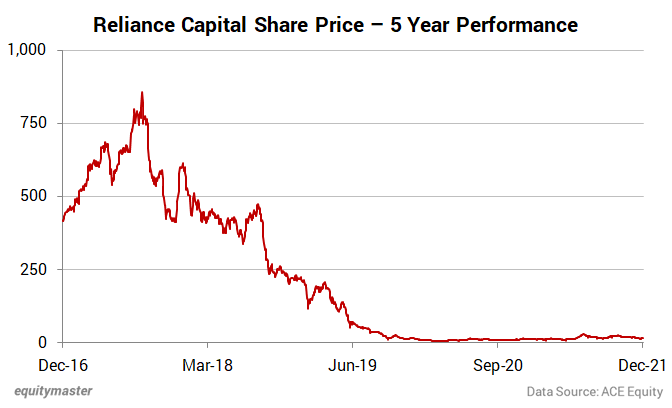
The fallout of Reliance Capital brought to the table the debate on whether large business houses can be trusted with banking licenses.
For the time being, the RBI has done well and has not agreed to open the floodgates of banking to large industrial houses, as recommended last year by an internal working group.
#2 Yes Bank
No prizes in guessing this name. You probably thought of Yes Bank when you clicked on this article.
Yes Bank has eroded 94% wealth in the past five years. In under 3 years, Yes Bank went from being a darling of investors to a pariah.
It all started in 2017 when the RBI forced Yes Bank to disclose big divergence in its non-performing loans of Rs 42 bn reported in the bank's audited accounts for the year ended March 2016.
The divergence further widened to almost Rs 64 bn a year later. To put this in perspective, the RBI audit had pegged its total gross non-performing assets (NPAs) at 5% for FY16, against the bank's own assessment of only 0.8% for the same year.
After a year, the RBI refused to give Yes Bank CEO Rana Kapoor an extension to his term as MD. Kapoor did fight back but it always seemed like a battle he was set to lose.
Then came a big whammy when rating agency Moody's cuts bank's rating outlook to 'negative' from 'stable' citing concerns over corporate governance. For a bank, its credit rating is everything.
Yes Bank then raised funds from private equity firms and global investors but all this did not go well. The credibility of the investors was questioned.
Starting 2019, Yes Bank reported more-than-expected losses, its NPA to loans ratio swelled along with its provisions.
The RBI then imposed a limit of Rs 50,000 on withdrawals. Then as usual, SBI bailed out Yes Bank.
The stock of Yes Bank has certainly proved to be a nightmare for investors. It's as if the bottom has fallen out of Yes Bank's stock.
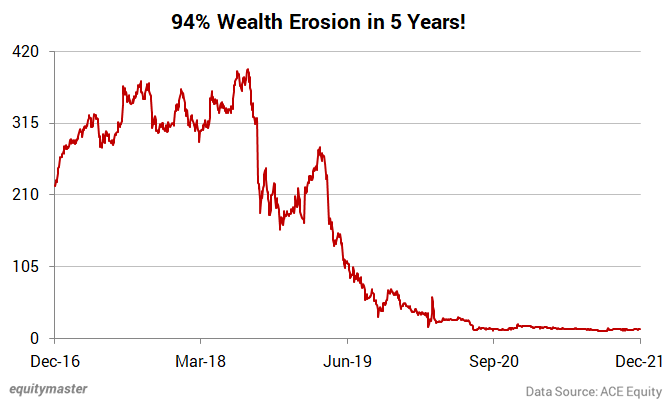
The Yes Bank debacle left many lessons for the Indian banking industry.
#3 SREI Infrastructure Finance
The IL&FS debacle in 2018 led to a liquidity crisis in the financial sector for NBFCs like SREI Infra. This in turn, affected its business growth.
In addition, there were problems in the infrastructure sector which led to stress on the books for SREI on delays in payments by clients.
The SREI group had an initial public offering (IPO) planned for SREI Equipment but that was shelved.
Instead, the boards of both companies decided to transfer the lending business, interest earning business & lease business of SREI Infra together with associated employees, assets and liabilities, as a going concern, by way of slump exchange to SREI Equipment.
Later, the company was stuck by a huge blow due to Covid-19 pandemic. Infra projects came to a halt and projects of borrowers were stuck.
The RBI then conducted an audit and flagged more than Rs 80 bn worth of probable related-party lending by the SREI group.
Then this year, the RBI said it's enough and took SREI Infra Finance for insolvency proceedings.
From trading at Rs 130 plus levels back in 2017, the stock of SREI currently has penny stock status and trades at Rs 5.
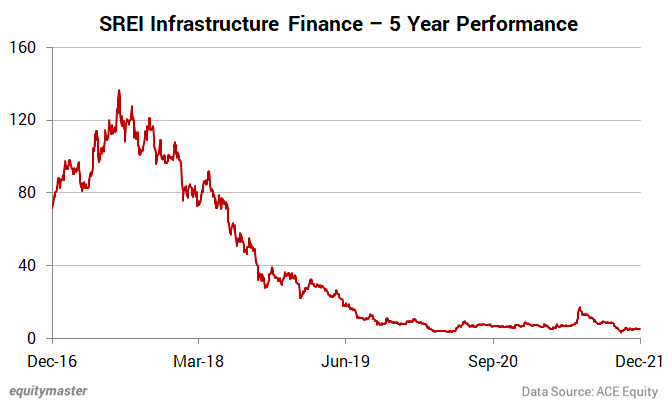
#4 Reliance Communications
Another Reliance group company which makes the cut is Reliance Communications.
Well before Reliance Jio came into the picture, Reliance Communications (RCom) disrupted the telecom sector. When other operators charged between Rs 4-6 per minute even for incoming calls, RCom offered them for free with a Rs 500 handset.
Anil Ambani grabbed users through an aggressive pricing strategy which was 60% cheaper than rivals.
However, the company's choice of technology in CDMA early on, made it invest capital into expanding into 3G and GSM services. That's when the troubles started. RCom discovered CDMA services generated less revenue than GSM.
So it invested heavily to roll out GSM services and eventually ended up with massive debt. Over the years, debt ballooned and RCom was unable to reduce it due to falling revenues.
Reliance Jio's entry was yet another trigger towards RCom finally bringing down the curtains on its 2G and 3G services.
RCom tried to find a solution, one of which was a proposed merger with Aircel, but the deal fell through.
Over the past five years, shares of the company are down over 85%.
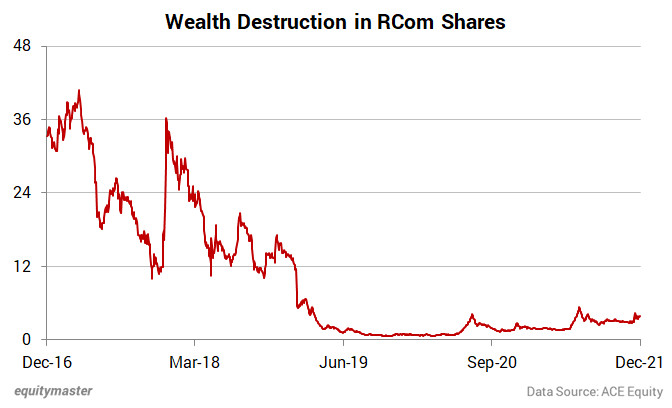
As things stand now, RCom is saddled with debt. The department of telecommunications (DoT) refused to renew its telecom license unless it clears statutory dues of Rs 260 bn.
#5 Sadbhav Engineering
Sadbhav Engineering is a construction and engineering company which develops infrastructure facilities in fields of canals, irrigation projects, road, bridges, mining projects, dams, etc.
In January 2018, the company's stock was trading over Rs 400. Skip forward to the present and the stock trades at less than Rs 50. A wealth destruction of over 85%.
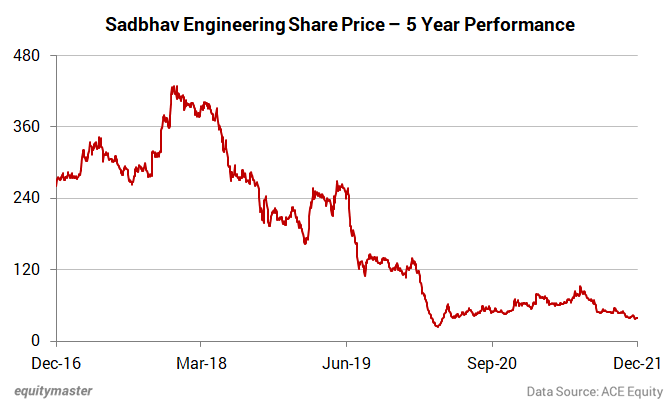
The stock's downtrend is in line with its results. The EPC company reported a consolidated loss of Rs 1.5 bn this year in the June quarter. This was its ninth losses out of past ten quarters.
At present, the company is trying to survive through asset monetisation, raising of funds via all means possible and staying afloat so that it can push for a revival.
As things stand now, Sadbhav Engineering has almost exhausted its working capital limits and debt obligations.
The company raised about Rs 9.9 bn in the March 2021 quarter through the sale of a 7% stake in IndInfravit Trust. This money was used for repayment of NCDs of Rs 6.9 bn and towards equity commitment of Rs 2.7 bn for HAM projects.
To know more about the company, check out Sadbhav Engineering's 2020-21 annual report analysis.
Which other companies have been the biggest wealth destroyers?
Apart from the above, here are other companies which have fallen the most in the past five years.
| Company | Date | Price | Date | Price | % Change |
|---|---|---|---|---|---|
| GFL Ltd. | 27-Dec-2016 | 466.35 | 27-Dec-2021 | 69.95 | -85% |
| Sadbhav Infrastructure Project Ltd. | 27-Dec-2016 | 92.50 | 27-Dec-2021 | 14.49 | -84% |
| Mcleod Russel India Ltd. | 27-Dec-2016 | 139.75 | 27-Dec-2021 | 27.05 | -81% |
| Reliance Infrastructure Ltd. | 27-Dec-2016 | 456.10 | 27-Dec-2021 | 90.75 | -80% |
| Entertainment Network (India) Ltd. | 27-Dec-2016 | 808.70 | 27-Dec-2021 | 165.70 | -80% |
| Dish TV India Ltd. | 27-Dec-2016 | 83.10 | 27-Dec-2021 | 19.15 | -77% |
| Gayatri Projects Ltd. | 27-Dec-2016 | 122.67 | 27-Dec-2021 | 29.90 | -76% |
| D.B. Corp Ltd. | 27-Dec-2016 | 360.25 | 27-Dec-2021 | 89.95 | -75% |
| Navkar Corporation Ltd. | 27-Dec-2016 | 159.80 | 27-Dec-2021 | 40.40 | -75% |
| Hindustan Media Ventures Ltd. | 27-Dec-2016 | 262.80 | 27-Dec-2021 | 68.45 | -74% |
The takeaway
So these were the biggest wealth destroyers of past five years.
For individual investors, the biggest lesson to learn here is to not confuse the cheapness in share price for cheapness in valuations. Do not blindly buy shares of battered stocks expecting them to rebound to their earlier levels.
When stocks start to fall and touch new lows, investors often get interested, hoping to make quick gains. But these kind of stocks tend to fall even more, destroying even more wealth. These stocks are called value traps. They appear to offer value, but in reality, they are traps.
They have certain red flags such as loan defaults, rating downgrades, selling of pledged shares, rising debt, and poor earnings.
You must learn to differentiate opportunities from traps. To do so, the first thing you should keep in mind is that just because a stock is beaten down, doesn't justify buying it. A consistent fall can actually be a sign of something grim.
As its said, investing is simple but not easy. Stock selection is tricky but with the right fundamental analysis and margin of safety, one can make it big.
Luckily, Equitymaster has a checklist which saves you from toxic stocks.
This checklist is a great tool, especially in current times where a lot of cockroaches are being discovered from the financial kitchens of small and mid-sized companies.
- 8 Figure Fortune Masterclass: Find the Best Stocks of the Decade With My Proven AAA Checklist
- My 4-Point Checklist to Avoid Stocks Like Jet Airways
- Your Correction Checklist... and What to Make of the Crypto Carnage
- Is this the best way to avoid toxic stocks?
- A checklist to manage risk
- The 5-Point Checklist to Save You from Toxic Stocks
- Is Indiabulls Housing the Next Yes Bank?
Disclaimer: This article is for information purposes only. It is not a stock recommendation and should not be treated as such. Learn more about our recommendation services here...

Yash Vora is a financial writer with the Microcap Millionaires team at Equitymaster. He has followed the stock markets right from his early college days. So, Yash has a keen eye for the big market movers. His clear and crisp writeups offer sharp insights on market moving stocks, fund flows, economic data and IPOs. When not looking at stocks, Yash loves a game of table tennis or chess.


Equitymaster requests your view! Post a comment on "What India's Top 5 Biggest Wealth Destroyers Can Teach You About Investing...". Click here!
Comments are moderated by Equitymaster, in accordance with the Terms of Use, and may not appear
on this article until they have been reviewed and deemed appropriate for posting.
In the meantime, you may want to share this article with your friends!